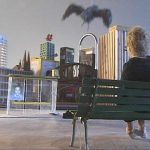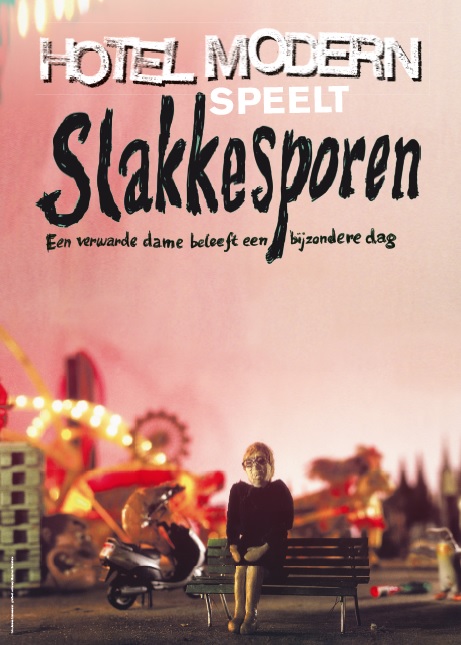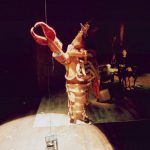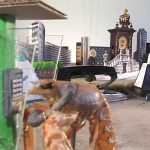


- Premiere Year 2001
Snail Trails offers a surrealistic view of a day and a night in the life of an elderly and somewhat confused woman. She spends her days snipping pictures from magazines and watering her plants.
Through her eyes, we see a world where objects and memories take on a life of their own, appearing and disappearing as they please. When late afternoon comes, she decides to leave her house, and time and space become elastic. She goes for a walk in town – where passers-by look suspiciously like shrimps – and ends up at a remarkable destination.
This poignant play without dialogue interweaves live theatre and animation film.
Snail Trails was nominated for the 2002 VSCD Mime Award. From the jury report: "It is a breath-taking spectacle that transports the audience to that borderland between fantasy and reality and offers confused human beings the solace of a magical imagination."
"It is quite astonishing how the technically adept artists of Hotel Modern manage to evoke such feelings, emotions and associations using the most modest of resources." (NRC Handelsblad)
"Hotel Modern have delivered a visually stunning piece that elicits melancholy sighs and relieved smiles in equal measure." (Volkskrant)
"Time slows down in Snail Trails, but it never becomes boring. On the contrary, it gets sharper and more intriguing, thanks to strong acting of Arlène Hoornweg as an old woman. With incredible control, she creates a painfully stiffened body and the decline of her mind. This provides plenty of beautiful, sometimes hilarious and certainly touching moments." (Theaterkrant)

-
Reviews & articles
-
Visually stunning take on a weighty subject
It is not a sad play. The witty and all-defining mise-en-scène breathes air into the weighty subject matter. In this way Hotel Modern manages to deliver a delightful piece that elicits a melancholic sigh and a relieved smile.
by Karin Veraart, Volkskrant Read the whole review
The old lady has got a slightly surprised expression on her face – then a little scared, then somehow curiously neutral. She lives alone. Her dress is not as clean as it once was, and neither is her home. She’s somewhat confused. Memories and thoughts tumble over each other and play games with her. She has almost no perception of time.
Snail Trails is the title of Hotel Modern’s new play that depicts a day and a wakeful night in the life of this little human. The Rotterdam theatre collective displays the same great precision and attention to detail as in their earlier, award-winning play The Great War. Here, all attention is focused on the alienation and fear that strikes when the brain ceases working as it once did. At first sight, the old lady’s house looks perfectly normal, but household objects are soon giving her the runaround. The table loses a leg, something bulges under the carpet, the teapot and the fruit bowl lead a life of their own – these are just a few of the surprises that the ingeniously designed set has in store for them.
Actrice Arlène Hoornweg plays the woman. She doesn’t talk – who would she talk to anyway? Her body language is enough, expressing by turns the wonderment, fear and a kind of contentment in response to the befuddlement that keeps overwhelming her, but which she is trying to cope with in her own way. The woman has no name; she is one of so many – a fact emphasized in the second part of the play, which Hotel Modern has shaped as an animated film. We see the woman on her night-time meanderings through the big city where she lives. She makes no contact, she is completely isolated, and the street scenes (in which shrimps play an important role) are even more surreal than the strange domestic scenes.
Yet Snail Trails is not a sad play. The witty and all-defining mise-en-scène breathes air into the weighty subject matter. In this way Hotel Modern manages to deliver a delightful piece that elicits a melancholic sigh and a relieved smile.
31-12-2001
-
Hotel Modern shows the despair of a lady with dementia
It is astonishing how Hotel Modern’s technically ingenious theatre makers manage to evoke all these thoughts, emotions and associations with just a few of the very simplest of tools and objects.
by Kester Freriks, NRC Handelsblad Read More
The elderly lady at the centre of Rotterdam theatre company Hotel Modern’s Snail Trails is disoriented. Her eyes have the surprised, unseeing lustre of dementia, and her movements are woefully uncertain. What’s more, her living room is haunted: the objects in it have lives of their own. While she focuses on reading a garden magazine called Growth & Bloom, in an exemplary example of dramatic irony a spider spins its web between her demented head and a pig’s head hanging on the wall. A table leg suddenly snaps off; a penguin rolls past on wheels. She suddenly finds herself with a hugely overgrown left hand, causing surprise and horror in equal measure.
It is a tragic image of mental despair and confusion that Hotel Modern gives – and for those who have ever been to an old people’s home or nursing home, what we see here comes frightfully close. The sole cast member, Arlène Hoornweg, imitates in detail the way people with dementia look and move. The shuffling gait; the uncertain, groping hands. Yet the play is more than a silent portrait of dementia.
This company is dedicated to making theatre in which animated film, the visual arts and music go hand in hand. Once the old woman has very cautiously used a staircase to step down from stage, we are presented with a second play. As in the group’s earlier production The Great War (2001), the drama shifts from stage to screen. In a surrealistic big-city setting, the actor has become a small puppet who wanders in in a state of astonishment through the urban jungle. In this total re-creation in scale-model form we recognize familiar fragments of the skyline of Rotterdam or Berlin. The viewer’s experience of these noisy, busy and polluted metropolises is shot through with the confusion in the woman’s eyes. Rather than people, the buses transport big shrimps of the same type that appeared from her biscuit tin in the first act. Cars have been transformed into electric irons. I was particularly impressed by the scene in which she experiences an almost complete 24-hour cycle: from afternoon, to evening, to midnight with its wailing sirens, to the new dawn. All she does is sit there, lonely, her only company a starling-like bird made of feathers and paperclips.
And then something surprising happens: she takes a lift that rises at dizzying speed to the 800-and-somethingth floor of a skyscraper. The camera sweeps past the infinitely high building. Up on the roof is the bird, waiting for her, luring her to the edge of the abyss. The bird spreads its wings and flaps upwards; she follows him and she soars, like the bird, into the air– a beautiful ending. It is a pity, then, that there has to be a short apotheosis with smoke, a rhino and the old woman. Didn’t she, just a moment ago, rise up and escape the hostile world that had nothing more to say to her?
Snail Trails can be seen as a play about farewell and a yearning for death. When life has nothing to more to offer than a dishevelled bird as your faithful companion, why would you continue to roam the asphalt. The high, thin air is surely much more attractive? You can also see it as a death scene, a death caused by the indifference of society.
It is astonishing how Hotel Modern’s technically ingenious theatre makers manage to evoke all these thoughts, emotions and associations with just a few of the very simplest of tools and objects: a puppet placed between two small cubes and then filmed. Perhaps the beauty of this picture lies in the contrast between the human being personified by a doll – which in everyone triggers thoughts of childhood – and the true nature of this doll: an old, intensely lonely woman you feel compassion for and to who you would like to offer an arm for support. But that is impossible.07-01-2002
-
Hotel Modern uses the theme of mortality to connect the everyday and the magical
Is the woman flying through space, unhampered by gravity, or is she giving sweets to the giant rhinoceros from whose mouth a hand projects? This poetic and absurdly humorous metaphor for death is comforting.
by Hana Bobkova, Financieele Dagblad Read the whole review
It’s all comings-and-goings (and waitings) in Snail Trails. This performance by Hotel Modern could also be described as the story of a woman descending into senility, but that would not do full justice to the work of this Rotterdam-based collective, producing since 1996. Snail Trails is a philosophical statement about life and death that is related to the work of absurdist writers such as Ionesco and Beckett and takes its lead from the Surrealists. In the performance, the fundamentals of human existence, time and space, lose definition and completely disperse into this magical world. At the close of the performance there even appears on stage, as a modern deus ex machina, a unicorn….
The materiality on display is affecting, even more so because not a word is spoken. On stage, the room and its inhabitant seem old-fashioned, old and shabby; the props are bizarre but real and the atmosphere is gloomy. The old woman in the green dress is not really old, although she moves with difficulty, shuffling; the ugly brown walls of the abode are cardboard. A large hat and a faded jacket hang on the hat stand; boots stand at its foot; a photo of a rhinoceros adorns the wall. Below this stands a plant in the shadow of light emanating from a projector on the floor. To the left, under the head of a giant pig, the woman sits, performing her daily rituals in the strange world of her fantasies, nightmares and memories. But first of all, light probes the darkness: an utterly commonplace wall lamp moves all about with her arm. Together with her, we look around.
A cup is pushed on to the table through the wall by the hand of an unseen person, another sets the coffee pot down. Someone, concealed by hat, jacket and boots, walks away. The woman pulls a large prawn from the biscuit tin and ponders it with curiosity and slight surprise. Ponderously, she gets her legs moving and reaches the other side of the room, touches a cross on the wall there and carries a banana across the space, like a candle, in her outstretched arms. The somewhat unpleasant atmosphere is moderated by harpsichord music when the woman put a record on. The visual dramaturgy is inspired by the fantastical world of fairytales. The central motif is an in-and-out movement, but the woman’s nightmares, the rather forced materializations of Freudian symbols that torment her, are also key.
In this first part of the performance, the experience – for both the woman and the observer – is not particularly intense and what is on display is neither shocking nor by any means new. The actress portraying the woman successfully evokes the stiffness of limbs and a repetition of movement that seems to be driven not by the mind, but only by habit. She is nonetheless not sufficiently mechanical to become a ‘panoptical figurine’ his life is reduced to a number of functions, because she is stuck in a naturalistic, imitative reproach. With hindsight, this was perhaps the intention, because the meaning and metaphorical value of this first section only become evident in combination with the second part, a film in which the woman takes on the form of an entirely objectified human, a puppet, a marionette.
The transition into another form of existence is marked by a kind of visual and aural dance macabre. Half of the plant disappears, the clock on the wall speeds up and stops, the telephone rings but there is no one at the other end of the line, the table falls and thick syrup runs over the tabletop, the walls become elastic and slide apart. The woman disappears behind a red curtain and on stage a huge prawn cuts through a rope allowing the projection screen to descend.
This great rupture between the material, dimensional world of the objects and the body, on the one hand, and the magical world of the animation film, on the other is absolute and results in a radically altered perception. One form replaces the other but they are connected by the movement in and out; going by coming.
In this fantasy world created by an artist, the woman, now a puppet, visits various spaces: a department store, a fun fair, a restaurant. These are all places belonging to nobody and everybody, where events and potentiality run parallel; past and present coalesce, but equally the here and now is very much at hand. She wanders this urban landscape of colorful lights, transparent as a lollipop, and eventually finds a place on the bench opposite the bus stop.
On the escalator in a department store she ascends together with the prawns, at a funfair she sees an enormous octopus revolve, irons race by at deafening volume, prawns step in and out of a bus and the heavens take on the red hue of evening, day becomes night, then morning glow returns.
Hitchcock’s archetypal messenger also plays a role in this fascinating and magical world of film: as if the crow’s gaze represents the camera, together with him we follow the feet and the footsteps of the woman. And then with dizzying speed, the lift passes hundreds of floors to the roof, surrounded by mist-bound nothingness. Is the woman flying through space, unhampered by gravity, or is she giving sweets to the giant rhinoceros from whose mouth a hand projects? This poetic and absurdly humorous metaphor for death is comforting.
Hotel Modern’s approach, combining stagecraft, film, visual arts and music, is successful. It is also amusing when they poeticize the absolute banality of everyday reality, disrupting established significations. Their prizewinning performance The Great War was also selected for The Theatre Festival. Their work recalls mixed media performances dating back several decades, but using their aesthetic pluralism the makers endeavor not to blend the various forms but rather to juxtapose them. In Snail Trails the meaning does not emerge through merging, but rather through the absolute aesthetic diversity; the theme of mortality viewed from the perspective of timeless time connects the material and the immaterial, the everyday and the magical…
2002
-
Nomination VSCD Mime Award 2002
A breath-taking spectacle that transports the audience to that borderland between fantasy and reality and offers confused human beings the solace of a magical imagination.
by the jury Read More
Snail Trails was nominated for the VSCD Mime Award 2002
The award jury’s report:
All the Hotel Modern’s plays explore the interplay of relationships, and Snail Trails marks a continuation of that journey. This play offers a glimpse into the mind of an elderly lady who is apparently losing her grip on her surroundings and her own body. The irregular tick-tocking of the clock by turns slows and accelerates time. Household objects suddenly appear at unexpected places. The hand of the woman as she stirs in her teacup is mimicked by an identical hand that appears through the wall to join in the stirring. A shrimp that emerges from a biscuit tin proves to be the herald of adventure that the woman experiences outside the house, in a city populated by shrimps. That adventure takes the form of a film in which the lonely lady is shrunk down to become a small puppet in a scale-model city. In the film the elderly woman’s alienation is conveyed movingly, inventively and in a sometimes childlike and naive way. Snail Trails offers a breath-taking visual display that transports the spectator to that interstitial space between fantasy and reality, and offers to the bewildered the solace of a fabulous imagination.
2002
-
Tourdates Snail Trails
- View all our tourdates in the agenda
-
Makers
-
Idea and role of elderly lady Arlène Hoornweg Creators Arlène Hoornweg, Kirsten Hutschemakers, Pauline Kalker, Herman Helle, Maartje van den Brink Stage assistants Mirijam Neve, Kirsten Hutschemakers Creator doll of woman in animation film Cathrin Boer Sound and music Johann Sebastian Bach, Arthur Sauer Technician André Goos Poster and flyer Maarten Evenhuis, with a photo by Arwen Linnemann Subsidy Performing Arts Fund NL, City of Rotterdam With thanks to Edwin van Steenbergen









